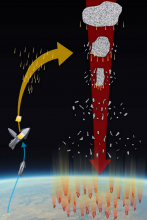Listen to today's episode of StarDate on the web the same day it airs in high-quality streaming audio without any extra ads or announcements. Choose a $8 one-month pass, or listen every day for a year for just $30.
You are here
Clam Beads
You don’t have to look into the sky to learn about Earth’s interactions with the rest of the solar system. Sometimes, all you need are some ancient clam shells. Fossil shells found in Florida suggest that it was pounded by one or more big space rocks a couple of million years ago.
The story began in 2006. Mike Meyer, a college student, was gathering fossils from a quarry near Sarasota, on the Gulf coast. Some of the clam shells he found contained tiny glass beads. No one could tell Meyer what the beads were, so he chucked them in a box.
A couple of years ago, Meyer decided to take a closer look at them. He and some colleagues subjected the beads to a battery of tests. They found that the beads probably are microtektites, which form in a collision between Earth and an asteroid.
Such an impact blasts huge amounts of debris into the atmosphere. It also melts some of the material. As it falls back to Earth, molten glass can be sculpted into tiny beads.
The Florida beads contain a lot of sodium. That suggests they formed nearby — perhaps from impacts in beds of salt off the Florida coast. The impacts may have taken place two million to three million years ago, although it’ll take more tests to confirm the dates.
So far, no one has found any other microtektites in Florida. That could mean that no one has been looking for them. But researchers may start keeping an eye out for them in the fossil clams they dig up along the Florida coast.
Script by Damond Benningfield






